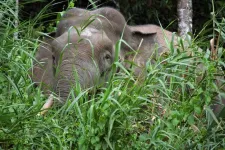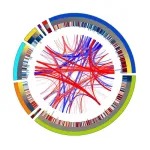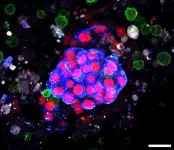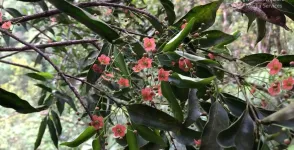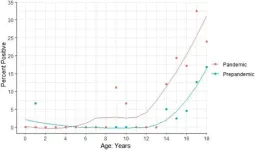(Press-News.org) The Pacific Ocean covers 32% of Earth’s surface area, more than all the land combined. Unsurprisingly, its activity affects conditions around the globe.
Periodic variations in the ocean’s water temperature and winds, called the El Niño–Southern Oscillation, are a major meteorologic force. Scientists know that human activity is affecting this system, but are still determining the extent. A new study in Nature has revealed that the atmospheric component of this system — called the Pacific Walker Circulation — has changed its behavior over the industrial era in ways that weren’t expected.
An international team of scientists — led by two who worked together at Washington University in St. Louis — also found that volcanic eruptions can cause the Pacific Walker Circulation to temporarily weaken, inducing El Niño-like conditions. The results provide important insights into how El Niño and La Niña events may change in the future.
“What happens in the tropical Pacific doesn’t stay in the tropical Pacific,” said Bronwen Konecky, an assistant professor of earth, environmental and planetary sciences in Arts & Sciences at Washington University. “It impacts vast stretches of the world. The Pacific Walker Circulation is a major driver of variability in global precipitation.”
Earth’s rotation causes warm surface water to pool on the western side of ocean basins. In the Pacific, this induces more humid conditions in Asia, with low-altitude trade winds blowing west across the sea. The high-altitude easterlies create an atmospheric circulation — the Pacific Walker Circulation — that drives weather patterns in the tropical Pacific, and far beyond.
Konecky said that when one looks at projections for future climate states for the world, “there’s an incredibly high model agreement, when it comes to future changes in temperature. There is a whole lot less agreement when it comes to future changes in rainfall.”
Climate models generally predict the Pacific Walker Circulation will weaken in response to global warming; however, its recent strengthening suggests that aerosols — the suspension of fine, solid particles or liquid droplets in air — introduced by human activity might have the opposite effect.
“We set out to [determine] whether greenhouse gases had affected the Pacific Walker Circulation,” said lead author Georgy Falster, a research fellow at the Australian National University and the ARC Centre of Excellence for Climate Extremes. “We found that the overall strength hasn’t changed yet, but instead, the year-to-year behavior is different.”
Falster worked with Konecky as a postdoctoral fellow at Washington University. Sloan Coats, at the University of Hawaii at Manoa, and Samantha Stevenson, at the University of California, Santa Barbara, are the other authors.
The scientists observed that the length of time for the Pacific Walker Circulation to switch between El Niño-like and La Niña-like phases has slowed slightly over the industrial era. That could exacerbate the associated risks of drought, fire, rains and floods, Falster said.
That said, the authors didn’t notice any significant change in the circulation’s strength — yet. “That was one surprising result,” Stevenson said. “Because by the end of the 21st century, most climate models suggest that the Pacific Walker Circulation will weaken.”
The team used data from ice cores, trees, lakes, corals and caves to investigate the long-term weather patterns of the Pacific over the past 800 years. The scientists combined these datasets with newer observational data, then used statistical methods to build out annually resolved reconstructions of the Pacific Walker Circulation.
“Our study provides long-term context for a fundamental component of the atmosphere-ocean system in the tropics,” Coats said. “Understanding how the Pacific Walker Circulation is affected by climate change will enable communities across the Pacific and beyond to better prepare for the challenges they may face in the coming decades.”
Volcanoes play a clear role
Among climate scientists, there has been a hot debate over the last few years about what the El Niño system does after a volcanic eruption, Konecky said. The Pacific Walker Circulation is the atmospheric component of that system.
“We have long known that large volcanic eruptions, especially from the tropics, tend to cool the planet off for a few years,” Konecky said. “But when it comes to hydroclimate, the impacts are harder to figure out, because rainfall and other hydroclimate variables are so much noisier than temperature. So, it’s just hard to tell: was it a little bit wetter this year because a volcano erupted near Fiji, or for some other reason?”
Volcanic eruptions have the power to impact climate on a global scale, but not every volcano has such impact. Previous research has shown that when there is a strong tropical volcano, the world tends to get a bit cooler.
In terms of potential impact on hydroclimate or rainfall, other scientists have been looking at whether volcanic eruptions change ocean temperatures, because the gradient of ocean temperatures across the tropical Pacific can set the stage for El Niño events. This new study tackles the impact of eruptions head-on by focusing on the behavior of the atmosphere, rather than ocean temperatures. The results were striking:
“Following a volcanic eruption, we see a very consistent weakening of the Pacific Walker Circulation,” Konecky said.
“This is not happening by chance. It’s something that is quite robust,” she said. “We see a consistent response in the atmosphere, whereas others have not seen the same response in ocean temperatures. And that’s either because the atmospheric response is stronger or it’s easier to detect.”
The study was funded in part by the National Science Foundation, under grants AGS-1805141, AGS-1805143, AGS-2041281 and OCE-2202794; and in part by the David and Lucile Packard Foundation. Portions of this content are courtesy of ARC Centre of Excellence for Climate Extremes.
END
Study: Atmospheric circulation weakens following volcanic eruptions
The Pacific Walker Circulation — and related El Niño and La Niña patterns — is changing because of human activity, volcanoes in the tropics
2023-08-23
ELSE PRESS RELEASES FROM THIS DATE:
How artificial intelligence gave a paralyzed woman her voice back
2023-08-23
Researchers at UC San Francisco and UC Berkeley have developed a brain-computer interface (BCI) that has enabled a woman with severe paralysis from a brainstem stroke to speak through a digital avatar.
It is the first time that either speech or facial expressions have been synthesized from brain signals. The system can also decode these signals into text at nearly 80 words per minute, a vast improvement over commercially available technology.
Edward Chang, MD, chair of neurological surgery at UCSF, who has worked on the technology, known as a brain computer interface, or BCI, for more than a decade, hopes this latest research breakthrough, appearing Aug. 23, 2023, ...
Wildlife overflow enriches biodiversity beyond park boundaries
2023-08-23
New research has discovered the power of large national parks to not only enhance bird diversity inside their borders but boost mammal diversity in nearby unprotected areas.
The University of Queensland’s Dr Matthew Luskin said the study, which involved using more than 2,000 cameras and bird surveys across Southeast Asia, reveals for the first time the benefit of expanding protected land areas around the globe beyond park boundaries.
“Protected area expansions are often a difficult and expensive process, but our results show they are absolutely worth it,” Dr Luskin said.
“We ...
Graphene: More magic starts when flatness ends
2023-08-23
Researchers from The University of Manchester and the University of Warwick finally solved the long-standing puzzle of why graphene is so much more permeable to protons than expected by theory.
A decade ago, scientists at The University of Manchester demonstrated that graphene is permeable to protons, nuclei of hydrogen atoms. The unexpected result started a debate in the community because theory predicted that it would take billions of years for a proton to permeate through graphene’s dense crystalline structure. This had led to suggestions that protons permeate not through the crystal lattice itself, ...
Researchers fully sequence the Y chromosome for the first time
2023-08-23
What was once the final frontier of the human genome — the Y chromosome — has just been mapped out in its entirety.
Led by the National Human Genome Research Institute (NHGRI), a team of researchers at the National Institute of Standards and Technology (NIST) and many other organizations used advanced sequencing technologies to read out the full DNA sequence of the Y chromosome — a region of the genome that typically drives male reproductive development. The results of a study ...
New research shows how cancer rewires a key immune pathway to spread
2023-08-23
A study led by researchers at Memorial Sloan Kettering Cancer Center (MSK) and Weill Cornell Medicine discovered a new relationship between cancer cells and the immune system, and shows how cancer can selfishly hijack a normally helpful immune pathway.
Usually, activation of this key immune pathway — called the STING pathway — triggers a strong inflammatory response that protects the body from foreign and unhealthy cells. But prolonged activation of the same pathway leads to a desensitization and ultimately to a “rewiring” of cellular signaling, which aids and abets cancer’s spread, the researchers found.
“You might think of ...
Graphene discovery could help generate hydrogen cheaply and sustainably
2023-08-23
Researchers from The University of Warwick and the University of Manchester have finally solved the long-standing puzzle of why graphene is so much more permeable to protons than expected by theory.
A decade ago, scientists at The University of Manchester demonstrated that graphene is permeable to protons, nuclei of hydrogen atoms.
The unexpected result started a debate in the community because theory predicted that it would take billions of years for a proton to permeate through graphene’s dense crystalline structure. ...
Adding immunity to human kidney-on-a-chip advances cancer drug testing
2023-08-23
By Benjamin Boettner
(Boston) — A growing repertoire of cell and molecule-based immunotherapies is offering patients with indomitable cancers new hope by mobilizing their immune systems against tumor cells. An emerging class of such immunotherapeutics, known as T cell bispecific antibodies (TCBs), are of growing importance with several TCBs that the U.S. Food and Drug Administration (FDA) approved for the treatment of leukemias, lymphomas, and myelomas. These antibody drugs label tumor cells with one of their ends, and attract immune cells with another end to coerce them into tumor cell killing.
One major challenge in the development of TCBs and other immunotherapy ...
Fungus gnats as pollinators not pests
2023-08-23
Many plants and crops rely on insects to pollinate them so they can reproduce. A new study has shown that several flowering plants from the group Euonymus are pollinated by fungus gnats, a dipteran insect. Specifically, they pollinate Euonymus plants which have red-petaled flowers with short stamens and yogurt-like scent. Although fungus gnats are known to pollinate hundreds of plant species, this study shows that the particular traits of red Euonymus flowers were likely to have been acquired via pollination syndrome, evolving over a process of natural selection to be pollinated specifically by fungus gnats. This research highlights the important role of Diptera, which are commonly regarded ...
Solar powered irrigation: a game-changer for small-scale farms in sub-Saharan Africa
2023-08-23
In sub-Saharan Africa 80% of agricultural production is from smallholder farmers, who face constraints on increasing farm productivity resulting in a large yield gap. Extensive rain-fed agriculture (90% of all cropland) under unpredictable and erratic rainfall pattern is a leading cause of the low productivity and food insecurity in Africa, together with a low degree of mechanization. This has been reinforcing a persistent poverty trap, triggered by cyclical famines that are jeopardizing local development opportunities.
In a new IIASA-led study as part of the research project Renewables for African Agriculture (RE4AFAGRI), an international ...
Looking out for kids: a case for better pediatric trauma interventions
2023-08-23
In the weeks following the onset of the COVID-19 pandemic, public health directives called for masking, social distancing, social isolation, and stay-at-home orders. Apart from the severe medical consequences as a direct result of the pandemic, the ensuing social isolation had far-reaching impacts on children. The pandemic control measures affected the pediatric population by increasing mental distress, limiting physical activity, changing sleep patterns, and reducing emergency room visits. Unfortunately, the scope of pediatric trauma during the pandemic remains ...
LAST 30 PRESS RELEASES:
HKUST Engineering researchers developed a novel photodetector to enhance the performance of on-chip light monitoring
Strategic river sensors could have forewarned of Texas Camp flood disaster
Drone sampling of whale breath reveals first evidence of potentially deadly virus in Arctic
Roman soldiers defending Hadrian’s Wall infected by parasites, study finds
Pinochet’s prisoners were tormented with music but still found solace in it, a new book reveals
Fertility remains high in rural Tanzania despite access to family planning
AI-assisted device can improve autism care access
Kinetic careers
Uncovering how parasitic plants avoid attacking themselves to improve crop resistance
Nanoparticle vaccine strategy could protect against Ebola and other deadly filoviruses
Study finds brain care score can predict risk of stroke across racial groups
Key lung immune cells can intensify allergic reactions
Do hormones explain why women experience more gut pain?
New materials conduct ions in solids as easily as in liquids
Breakthrough of the Year: Renewable energy begins to eclipse fossil fuel-based sources
LLM use is reshaping scientific enterprise by increasing output, reducing quality and more
Introducing LightGen, a chip for ultra-fast, ultra-efficient generative AI
Astronomers see fireworks from violent collisions around nearby star
ACC/AHA issue new guideline on managing congenital heart disease in adults
Cosmic crash caught on camera
Is talented youth nurtured the wrong way? New study shows: top performers develop differently than assumed
Ants: An untapped resource in the development of antibiotics?
Archaeologists use AI to create prehistoric video game
Mitochondria migrate toward the cell membrane in response to high glucose levels
Tiny viral switch offers hope against drug-resistant bacteria
Most parents aware of early peanut introduction guidelines, but confused about details
HPV vaccine can protect against severe lesions of the vulva and vagina
Virtual care provision and emergency department use among children and youth
Quadrivalent HPV vaccine and high-grade vulvovaginal lesions
Insights into dry eyes gained from stem cell-derived tear glands
[Press-News.org] Study: Atmospheric circulation weakens following volcanic eruptionsThe Pacific Walker Circulation — and related El Niño and La Niña patterns — is changing because of human activity, volcanoes in the tropics
